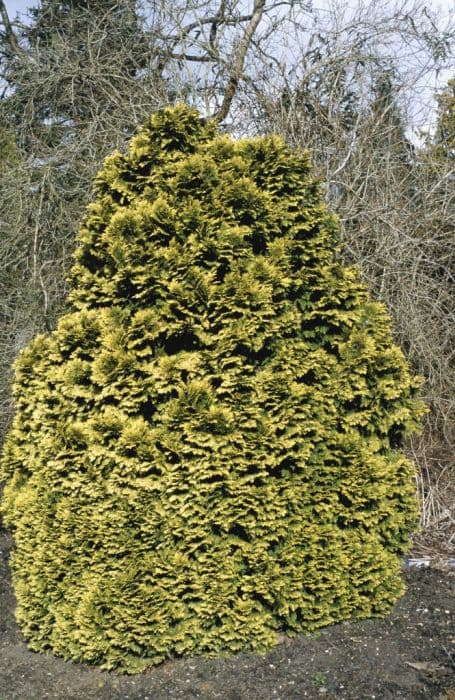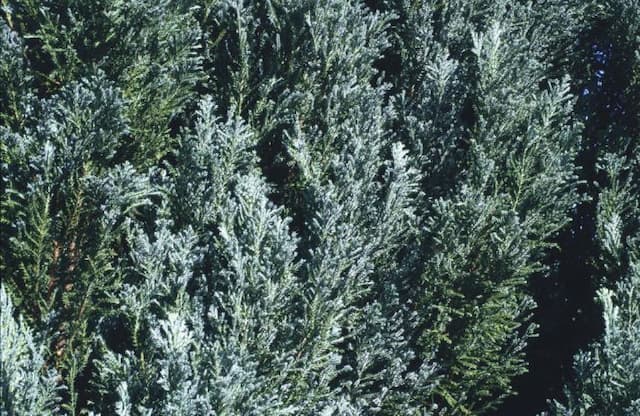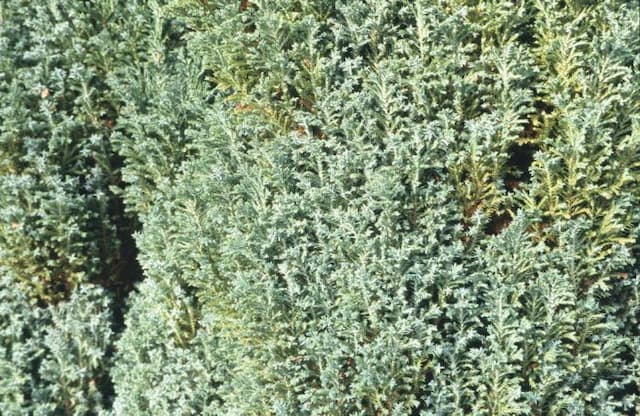Blaauw Chinese Juniper Juniperus chinensis 'Blaauw'











ABOUT
The Blaauw Juniper is a coniferous evergreen shrub known for its distinctive foliage and growth habit. Its needle-like leaves are a striking blue-green color, possessing a silvery-blue hue that adds a cool, calming touch to any landscape. The leaves are tightly arranged in clusters, giving the plant a dense, textured appearance. Over time, the foliage may become more intense in color, especially in the cooler months, accentuating its silvery blue shades. The plant has a naturally sculptural form, often described as conical or somewhat pyramidal in shape, with a tendency to sprout horizontally spreading branches. These branches give the Blaauw Juniper a full-bodied look and can sometimes appear to be slightly cascading, adding to its visual interest and making it a sought-after choice for gardens. Its overall appearance exudes an aura of strength and vigor, while maintaining an air of refined grace, making it a versatile choice for a variety of landscape styles.
About this plant
 Names
NamesFamily
Cupressaceae
Synonyms
Blaauw Chinese Juniper, Blaauw Juniper
Common names
Juniperus chinensis 'Blaauw'.
 Toxicity
ToxicityTo humans
Chinese Juniper is not considered highly toxic to humans, but it can cause mild intestinal upset if ingested in large quantities. Most parts of the plant can be irritating to the skin and mucous membranes upon prolonged contact. If berries or foliage are consumed, symptoms might include stomach pain, nausea, vomiting, or diarrhea.
To pets
Chinese Juniper can also be toxic to pets, particularly if they consume a large amount of the plant. The most common symptoms of poisoning in pets might include vomiting, diarrhea, and in severe cases, central nervous system issues or respiratory problems. Pet owners should ensure that their animals do not chew on or ingest parts of this plant to avoid possible negative health effects.
 Characteristics
CharacteristicsLife cycle
Perennials
Foliage type
Evergreen
Color of leaves
Blue-green
Height
4-6 feet (1.2-1.8 meters)
Spread
5-7 feet (1.5-2.1 meters)
Plant type
Shrub
Hardiness zones
4-9
Native area
China
Benefits
 General Benefits
General Benefits- Low Maintenance: This plant requires minimal pruning and care once established, making it a good choice for those who prefer a low-maintenance landscape.
- Drought Tolerance: It can withstand periods of dryness, reducing the need for frequent watering and making it suitable for xeriscaping.
- Year-Round Interest: Its blue-green foliage remains attractive throughout the seasons, providing consistent interest in the garden.
- Pest Resistance: It is generally resistant to many pests, which means fewer chemical treatments are necessary.
- Erosion Control: The robust root system helps to stabilize slopes and control erosion.
- Wildlife Attraction: It provides shelter and sometimes berries for various types of wildlife, such as birds.
- Versatility: Due to its dense growth, it can be used for hedging, ground cover, or as a specimen plant in various styles of landscapes.
- Architectural Structure: It adds shape and texture to garden designs, with its striking form making it an excellent choice for both formal and informal settings.
 Medical Properties
Medical PropertiesThis plant is not used for medical purposes.
 Air-purifying Qualities
Air-purifying QualitiesThis plant is not specifically known for air purifying qualities.
 Other Uses
Other Uses- Wood Crafting: Juniper wood is quite aromatic and durable, making it ideal for crafting small wooden items such as jewelry boxes, ornaments, or even kitchen utensils.
- Bonsai Creation: Due to its slow growth and ability to be shaped, Juniperus chinensis 'Blaauw' is a popular choice for bonsai enthusiasts who trim and train the plant to create living art.
- Garden Sculpture: Its unique form and dense foliage make it a good candidate for topiary, where it can be trimmed into various shapes and figures for garden decoration.
- Bioengineering Projects: The sturdy root system of Juniperus chinensis 'Blaauw' can be used in soil erosion control, stabilizing slopes and assisting in the restoration of disrupted ecosystems.
- Natural Fencing: Because of its dense growth habit, this plant can be used in creating privacy screens or living fences between properties.
- Wildlife Shelter: Its thick branches and foliage provide excellent shelter and nesting sites for birds and small animals within a garden setting.
- Perfumery: The aromatic qualities of the wood and foliage can be used as a base for natural perfumes or to impart scent when included in potpourri mixes.
- Photography Props: Photographers may use this plant as a prop or backdrop due to its attractive and structured appearance that adds a touch of natural elegance to photos.
- Ground Cover: When planted en masse, it can act as an effective ground cover, minimizing weed growth and reducing the need for additional mulch.
- Cultural Practices: In some cultures, the foliage may be used in traditional ceremonies or festive decorations, symbolizing protection or purification.
Interesting Facts
 Feng Shui
Feng ShuiThe Juniper is not used in Feng Shui practice.
 Zodiac Sign Compitability
Zodiac Sign CompitabilityThe Juniper is not used in astrology practice.
 Plant Symbolism
Plant Symbolism- Protection: Juniper plants have been used for centuries in various cultures as a means to ward off evil spirits and provide protection.
- Purity: The clean and sharp fragrance of juniper is often associated with purification and cleansing rituals.
- Healing: Juniper has medicinal properties, and as such, it symbolizes healing and the alleviation of ailments.
- Endurance: As a hardy plant that can thrive in difficult conditions, juniper represents endurance and the ability to persevere.
- Sanctity: In some traditions, juniper is considered sacred and is used in spiritual practices, symbolizing a connection to the divine.
 Water
WaterThe Chinese juniper 'Blaauw' prefers to be watered thoroughly, allowing the soil to dry out somewhat between watering sessions. For outdoor plants, water once every 7 to 10 days, providing about 1 to 1.5 gallons depending on the size of the plant and the weather conditions. During hot, dry spells, increase watering frequency, but in cooler or rainy periods, reduce it. Junipers dislike waterlogged soil, so ensure good drainage to prevent root rot.
 Light
LightChinese juniper 'Blaauw' thrives in full sun to partial shade. It is best positioned in a spot that receives at least 6 hours of direct sunlight daily. While it can tolerate some light shade, too much shade can lead to poor foliage density and less robust growth.
 Temperature
TemperatureThe Chinese juniper 'Blaauw' can endure a wide range of temperatures, from as low as -20°F to highs exceeding 100°F. However, its ideal growing conditions are within the 60°F to 80°F range. This juniper is hardy and can often survive slightly outside these temperature extremes, making it a versatile choice for many climates.
 Pruning
PruningPruning the Chinese juniper 'Blaauw' is important to maintain its shape and encourage dense foliage. It should be pruned once a year, ideally in late winter or early spring before new growth begins. Remove any dead or damaged branches and thin out areas to improve light and air circulation.
 Cleaning
CleaningAs needed
 Soil
SoilThe Blaauw Juniper thrives in well-draining, sandy or loamy soil with slight acidity to neutral pH, ideally between 5.5 to 7.5 pH. A mix containing one-third sand, one-third garden loam, and one-third peat or compost can provide the optimal texture and nutrients for healthy growth.
 Repotting
RepottingBlaauw Juniper typically requires repotting every two to three years to prevent root bounding and refresh the soil. Younger plants may need more frequent repotting while mature specimens can be repotted less often.
 Humidity & Misting
Humidity & MistingBlaauw Junipers are adaptable plants that prefer low to average humidity levels. They are well-suited to outdoor conditions and typically do not require any special humidity considerations, making them versatile for various environments.
 Suitable locations
Suitable locationsIndoor
Grow Blaauw Juniper in a bright, cool location indoors with good air circulation.
Outdoor
Plant Blaauw Juniper in full sun to partial shade with well-draining soil.
Hardiness zone
4-9 USDA
 Life cycle
Life cycleThe life of the Blaauw Chinese Juniper (Juniperus chinensis 'Blaauw') begins with seed germination, which is often irregular and may require a period of cold stratification to overcome dormancy. Once germinated, the seedling grows slowly, developing a woody stem and evergreen, needle-like foliage, transitioning into a juvenile stage that can last several years. As the plant matures, it enters the adult stage, characterized by a growth spurt and the development of a conical to columnar shape, with dense, bluish-green foliage. During this phase, the juniper starts producing cones; male plants release pollen, while female plants develop berry-like structures called "juniper berries". After reaching full maturity, which can take many years, it continues to grow slowly, potentially living and remaining reproductive for several decades. The plant eventually enters senescence, characterized by reduced growth and vigor, culminating in death.
 Propogation
PropogationPropogation time
Early Spring
Juniperus chinensis 'Blaauw', commonly known as the Blaauw's Juniper, is often propagated by cuttings. The ideal time for taking cuttings for propagation is in late summer when the plant material is semi-hardwood, meaning it is not too soft or too hard. To propagate using cuttings, a healthy stem of about 4 to 6 inches (approximately 10 to 15 centimeters) is selected, ideally with foliage at the tip and mature wood at the base. The cutting's lower leaves are removed, and the cut end is often treated with a rooting hormone to enhance root development. Then, the cutting is inserted into a well-draining medium, such as a mix of peat and perlite. It should be kept moist, with high humidity, and in indirect light until roots have developed, which can take several weeks to a few months. Once rooted, the cuttings can then be potted up individually and grown on until they are ready to be planted outside.









